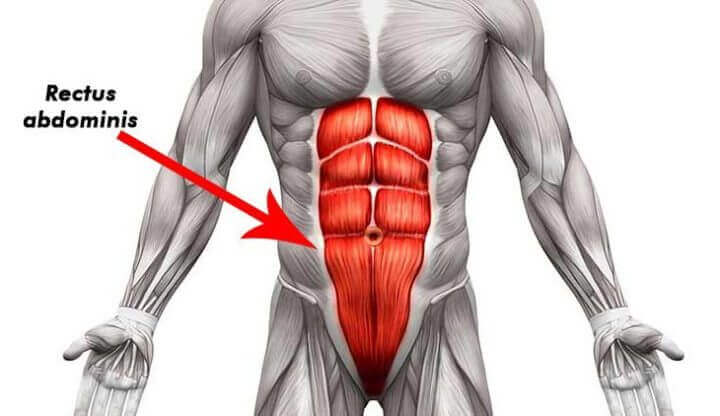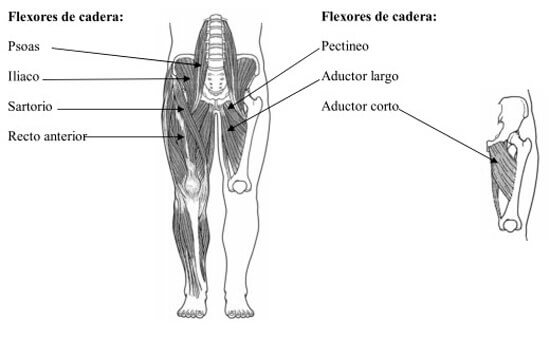What Function do the Abdominal Muscles Have?

The abdominal muscles keep us upright, they also reinforce the back and protect the viscera. The functions of the abdominal muscles are of vital importance to the body. The abdominal muscles are located between the lower part of the thorax and the pelvis.
What are the functions of the abdominal muscles?
The internal, external abdominal obliques, the transversus abdominis, and rectus abdominis protect the viscera. They also help to maintain proper posture and control respiration. When they contract, they increase intra-abdominal pressure, this is useful when we need to lift objects, sneeze, cough, urinate or give birth.
In conjunction with the paraspinal muscles, abdominal muscles play a role in the body’s movements from the moment a person gets up until they lie down. This is done in a harmonious and balanced manner.
The abdominal muscles also play a key role in helping the core coordinate actions with the brain and the rest of the body. They also stand out for their aesthetics attributes.
What are the abdominal muscles?
Rectus abdominis
The rectus abdominis is a long, flat muscle that lies between the ribs and the pelvic bone. Its main function is trunk flexion.
The rectus abdominis protects the viscera between the rib cage and the pelvis and it also helps maintain posture. It simultaneously plays an active role in respiration by maintaining intra-abdominal pressure.

When people do abdominal exercises in the gym, they usually focus on this muscle. The rectus abdominis is defined by a white line in the center known as the “alba line”. There are three other similar lines that give the rectus abdominis its characteristic shape that we seek to highlight through training.
The obliques
Another muscle that people focus on in the gym are the obliques. There are two types of oblique muscles; the internal and external.
The external obliques are the biggest of all the four abdominal muscles. They are located on the sides of the rectus abdominis and they extend from the ribs to the pelvis. They facilitate lateral torsion as well as rotation and flexion of the spine. The external obliques also play a role in protecting viscera.
The internal obliques are a pair of deep muscles that are located below the external obliques. They play a role in flexion of the spine. They also facilitate inclination and rotation. Along with the external obliques, they play a role in protecting the viscera.
The internal obliques counteract the external muscles during lateral flexion. In conjunction, they are known as reverse lateral rotators.

The transverse muscle
This is the deepest abdominal muscle layer. It’s located below the rectus abdominis and the obliques. It acts as a kind of girdle and it joins the stomach area with the rest of the abdominal structure.
This muscle protects and compacts the internal organs. It also plays a key role in the expiration of air from the lungs.
Are hip flexors abdominal muscles?
Hip flexors often work like abdominal muscles. However, they actually join the legs to the trunk. The rectus femoris, psoas iliacus, sartorius and the pectineus are large, solid muscles that aid abdominal contractions.

Abdominal pressure
Being one of the parts of the body that works out the most during workouts, it’s prone to episodes of tension. Cracks, tears, and stretches may occur during intense activities.
Inadequate rest after workouts is another cause of abdominal injuries. The consequences of increased abdominal pressure ranges from swelling and cramps to hernias.

If you feel dizziness, nausea or cold sweats when performing abdominal exercise you should consult your doctor. In order to avoid these issues, it’s important to stretch properly before training. Doing so after workouts is also vital.
You can counteract these problems with a few options. For example, you can apply cold presses in order to reduce irritation, pain, and swelling.
Heat treatment can also be employed to help your muscles relax as well as to reduce stress and minimize irritation. Analgesics and adequate rest are also prudent ways to prevent abdominal injuries.
The abdominal muscles keep us upright, they also reinforce the back and protect the viscera. The functions of the abdominal muscles are of vital importance to the body. The abdominal muscles are located between the lower part of the thorax and the pelvis.
What are the functions of the abdominal muscles?
The internal, external abdominal obliques, the transversus abdominis, and rectus abdominis protect the viscera. They also help to maintain proper posture and control respiration. When they contract, they increase intra-abdominal pressure, this is useful when we need to lift objects, sneeze, cough, urinate or give birth.
In conjunction with the paraspinal muscles, abdominal muscles play a role in the body’s movements from the moment a person gets up until they lie down. This is done in a harmonious and balanced manner.
The abdominal muscles also play a key role in helping the core coordinate actions with the brain and the rest of the body. They also stand out for their aesthetics attributes.
What are the abdominal muscles?
Rectus abdominis
The rectus abdominis is a long, flat muscle that lies between the ribs and the pelvic bone. Its main function is trunk flexion.
The rectus abdominis protects the viscera between the rib cage and the pelvis and it also helps maintain posture. It simultaneously plays an active role in respiration by maintaining intra-abdominal pressure.

When people do abdominal exercises in the gym, they usually focus on this muscle. The rectus abdominis is defined by a white line in the center known as the “alba line”. There are three other similar lines that give the rectus abdominis its characteristic shape that we seek to highlight through training.
The obliques
Another muscle that people focus on in the gym are the obliques. There are two types of oblique muscles; the internal and external.
The external obliques are the biggest of all the four abdominal muscles. They are located on the sides of the rectus abdominis and they extend from the ribs to the pelvis. They facilitate lateral torsion as well as rotation and flexion of the spine. The external obliques also play a role in protecting viscera.
The internal obliques are a pair of deep muscles that are located below the external obliques. They play a role in flexion of the spine. They also facilitate inclination and rotation. Along with the external obliques, they play a role in protecting the viscera.
The internal obliques counteract the external muscles during lateral flexion. In conjunction, they are known as reverse lateral rotators.

The transverse muscle
This is the deepest abdominal muscle layer. It’s located below the rectus abdominis and the obliques. It acts as a kind of girdle and it joins the stomach area with the rest of the abdominal structure.
This muscle protects and compacts the internal organs. It also plays a key role in the expiration of air from the lungs.
Are hip flexors abdominal muscles?
Hip flexors often work like abdominal muscles. However, they actually join the legs to the trunk. The rectus femoris, psoas iliacus, sartorius and the pectineus are large, solid muscles that aid abdominal contractions.

Abdominal pressure
Being one of the parts of the body that works out the most during workouts, it’s prone to episodes of tension. Cracks, tears, and stretches may occur during intense activities.
Inadequate rest after workouts is another cause of abdominal injuries. The consequences of increased abdominal pressure ranges from swelling and cramps to hernias.

If you feel dizziness, nausea or cold sweats when performing abdominal exercise you should consult your doctor. In order to avoid these issues, it’s important to stretch properly before training. Doing so after workouts is also vital.
You can counteract these problems with a few options. For example, you can apply cold presses in order to reduce irritation, pain, and swelling.
Heat treatment can also be employed to help your muscles relax as well as to reduce stress and minimize irritation. Analgesics and adequate rest are also prudent ways to prevent abdominal injuries.
All cited sources were thoroughly reviewed by our team to ensure their quality, reliability, currency, and validity. The bibliography of this article was considered reliable and of academic or scientific accuracy.
- Sadhana Escuela de formación. Musculatura del espacio abdominal. Extraído de: https://www.yogasadhana.eu/wp-content/uploads/2017/02/6%C2%BA-ANATOMIA-MUSCULATURA-ABDOMINAL.pdf
- Álvaro Robín Valle de Lersundi; Arturo Cruz Cidoncha. Anatomía de la pared abdominal. Manual de cirugía de pared abdominal compleja. Extraído de: https://www.berri.es/pdf/MANUAL%20DE%20CIRUGIA%20DE%20PARED%20ABDOMINAL%20COMPLEJA/9788416706549
This text is provided for informational purposes only and does not replace consultation with a professional. If in doubt, consult your specialist.








